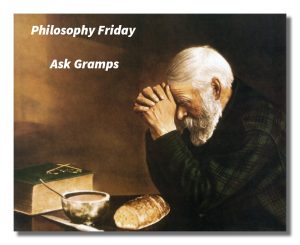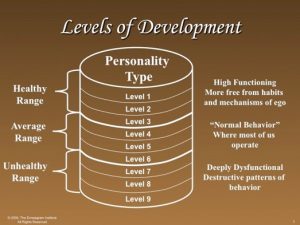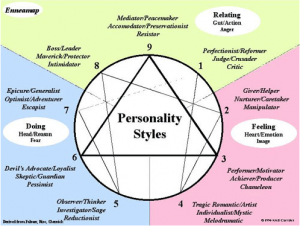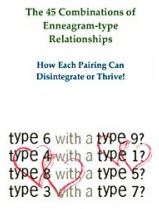
Shownotes
Wisdom-Trek / Creating a Legacy
Welcome to Day 1028 of our Wisdom-Trek, and thank you for joining me.
This is Guthrie Chamberlain, Your Guide to Wisdom
The Enneagram Type Combinations – 3&4; 3&5; 3&6 – Ask Gramps

Wisdom – the final frontier to true knowledge. Welcome to Wisdom-Trek where our mission is to create a legacy of wisdom, to seek out discernment and insights, and to boldly grow where few have chosen to grow before.
Hello, my friend, I am Guthrie Chamberlain, your captain on our journey to increase wisdom and create a living legacy. Thank you for joining us today as we explore wisdom on our 2nd millennium of podcasts. This is Day 1028 of our trek, and it is time for our Philosophy Friday series. Each Friday we will ponder some of the basic truths and mysteries of life and how they can impact us in creating our living legacy.
As we continue on this trek called life, sometimes we have questions about life, so our Friday trek is a time when we can “Ask Gramps.” Gramps will answer questions that you would like to ask your dad or granddad, but for whatever reason are unable to. No matter how old we are, I know that all of us would like the opportunity to ask Dad or Gramps questions about life in many areas.
Understanding ourselves and how others may interpret life through their paradigm better allows us to interact with each other with more love and compassion. This can be achieved by utilizing a profound tool called “The Enneagram.” The tool that we refer to as the Enneagram (Any-a-Gram) is a circle with nine interconnected points (Ennea refers to 9 and Gram referring to a drawing). Check out today’s or a prior week’s Wisdom Journal for a representation of it. I have also included a copy of “The Enneagram At-A-Glance,” which was compiled by Suzanne H. Eller in today’s Wisdom Journal. If you would like a PDF copy, click on the link in today’s Wisdom Journal located on our website Wisdom-Trek.com.
For additional insight, I recommend the book The Road Back to You written by Ian Morgan Cron and Suzanne Stabile. It is an excellent book about an enneagram journey to self-discovery from a Christian perspective.
We have concluded our deep dive into the nine types which are “The Reformer,” “The Helper,”“The Achiever,” “The Individualist,” “The Investigator,” “The Loyalist,” “The Enthusiast,” “The Challenger,” and “The Peacemaker.” Six weeks ago, we began a series of episodes on Type Combinations, answering the question, “What are the potential relationship benefits and issues with each combination?” Covering all of the 45 different potential type combinations will take several weeks, but will be valuable in understanding each other, regardless of what type you are and what type those with whom you interact with each day are.
Since we are exploring the Enneagram in detail, I would also recommend reading the Wisdom Journal for each Friday to see the diagrams presented each week. As helpful as the Enneagram is, keep in mind, it is still only a tool and cannot replace or usurp the precepts that are found in God’s Word. All decisions and actions that we make in life must be in harmony with God’s precepts.
So the questions for the next several weeks will be…
“Hey, Gramps, why do people act and react to situations and circumstances in life so differently? How can I gain wisdom to better understand myself and others so that I can love, serve, and minister to them on a deeper level?”
The Enneagram Type Combinations

The Enneagram Type Combinations
Enneagram Type Three (the Achiever)
with
Enneagram Type Four (the Individualist)
What Each Type Brings to the Relationship
These two types can form something of a complementary relationship, with each bringing important qualities to the relationship that the other generally lacks. Enneagram Fours can teach Threes how to talk about themselves on a deeper level and help acknowledge and process their feelings. They can also bring Threes more sensitivity, a feeling for beauty and for the non-practical but fulfilling aspects of life. Finding the Three’s heart’s desire is an extremely important area of self-awareness in which Fours can play a helpful role to Threes. Fours can bring a sense of style and presentation, rich communication, and a sense of refinement. Threes model many of the qualities that Fours would like to develop in themselves, and Threes are well-suited to helping Fours gain new skills. Threes can bring a good deal of tact and diplomacy in handling Fours’ emotional reactions and their sometimes too-sensitive feelings and self-doubts. Knowing what to say and when to say it—and what not to say—to a Four can be crucial for building trust in the relationship and avoiding inadvertent episodes when either feels humiliated or embarrassed. Threes can bring a sense of hope and ambition to the relationship, practical goal-setting, coaching and behavior management techniques that help Fours get out of a slump or a period of low energy. Threes can coach Fours on how to get on with practical matters and to act professionally despite the shifts in their feelings and self-doubts.
Since both types are driven by (often unconscious) feelings and reactions, this can be an intense and passionate coupling. Both are aware of “image” issues and about how others perceive them, and so this couple will be noteworthy for its energy, flair, sense of style, and enjoyment of the finer things of life. They may both feel a connection with the other that goes beyond words or reason into another realm as if they had known each other from a previous existence or that the other is some kind of soul mate.
Potential Trouble Spots or Issues
Both Threes and Fours have issues with self-esteem and with needing attention and validation from others. They both suffer from questions about their own identity and have hidden feelings of shame and worthlessness. These two types secretly compare themselves with others and have more or less openly competitive tendencies. Much will depend on how narcissistically wounded each person is—and therefore how much they will be vying for approval, attention, and recognition. Both Threes and Fours need attention and to feel appreciated although Threes will be more able to openly seek these things. Fours can feel overshadowed or shut out of the limelight by the more energetic Three. This can trigger feelings in Fours of being defective and deficient, which Threes may play on. Threes will tend to give less attention than Fours to the relationship itself, although both will tend to see the other as essential for their welfare. Fours will typically want far more emotional involvement and intimacy than Threes are comfortable with (or even capable of providing).
A related problem is that neither type really sees the other as they are: both see the other through projections of what they need and expect the other to be. Fours may see Threes as a rescuer and as the embodiment of everything they lack, whereas Threes may see Fours as an exotic, mysterious sexual or artistic trophy that enhances their desirability. Both types, however, can get into hostile rages if their emotional needs are not fulfilled. Perhaps worst for this pairing is that they inadvertently keep reminding each other of their own particular brand of self-concealment and phoniness—a constant source of irritation to each other. They can become snippy and sarcastic, gossiping and complaining about the shortcomings of the other to their own friends. Both can also be covert and indirect about sabotaging the other out of revenge, if their relationship should end. Once the respect and admiration they have had for each other ends, dismissiveness, contempt, and undermining begin—and the relationship itself is surely about to end.

Enneagram Type Three (the Achiever)
with
Enneagram Type Five (the Investigator)
What Each Type Brings to the Relationship
This is a frequently seen combination although one that might not be expected. Enneagram Fives often give Threes depth, new areas of expertise and credibility, while sparking creativity. Threes give Fives confidence, presentation skills, and awareness of the importance of communicating effectively with others. Both Threes and Fives are primarily focused on their work and on objective issues and concerns. Both types are preoccupied with competency and effectiveness, especially in their professional areas, and this is where they support each other in an outstanding way. Although both have deep feelings, both tend not to focus on them for the sake of getting on with their work. They tend to understand each other’s need to balance closeness with their need for personal space: they do not crowd each other. Threes contribute social skills, the ability to communicate and to sell ideas and projects, charm, energy, and a strong sense of practicality to the relationship. They can often see what is needed in the relationship or in the world and help to marshal the Fives’ skills toward that goal. Fives bring depth of understanding, expertise in one or more areas, perseverance with details until the goal is accomplished, an objective dispassion, and lack of attachment to outcomes.
This can be a “brilliant” couple—sharp, successful, deeply competent, and well respected. If they are attractive, Threes can be a trophy for Fives who are usually less concerned with appearance; Fives, on the other hand, can also be a trophy for Threes who are proud of the Five’s expertise and who are glad to learn from them whenever they can. Both regard the other as a catch who enhances their own self-esteem and social standing. Their deep, often unspoken, feelings for each other frequently deepen even more over time, gradually allowing this couple to discover not just passion but quiet affection and pride in each other.
Potential Trouble Spots or Issues
This couple’s emphasis on work and competency can also lead them into conflicts and tensions with each other. A great deal of their self-esteem is also derived from their work and how it is regarded by others. Threes and Fives can get into more or less open contentiousness over who was the original source of ideas and work. There can be elements of comparing one’s work and contributions, claims about who is responsible for which ideas or breakthroughs, and other forms of competitiveness coming not only from Threes but from Fives. Threes also tend to want to get on with the project or with whatever they feel needs to be done, while Fives tend to take a long time fine-tuning and tinkering until they feel that they are adequately complete. Conflicts can erupt over the use of time, resources, and priorities as the more practical-minded Three becomes increasingly impatient with the Five’s lengthy preparations but lack of action. Fives may also begin to lose respect for the ethical standards of Threes who they feel are ready to cut corners or exaggerate claims in order to accomplish goals or to stay ahead professionally.
Both types also tend to not speak directly about their feelings or misgivings about the relationship until it is too late: then they both can become sarcastic and hostile, icy and distant from each other. Fives can be too blunt and argumentative for Threes who can retaliate with sarcastic zingers and put-downs while pretending not to be hostile or irritated. Both types can be arrogant and impatient with the other, and as a couple, they begin to find little to admire in the other. Threes can seem shallow and dishonest to Fives, while Fives can seem weird and repulsive to Threes. Turning a negative situation around will depend on how much each needs the other, as well as the depth and breadth of other shared values, such as children and spiritual beliefs. If these are few, it will be difficult to salvage the relationship once their connection has been broken since both types tend to be suspicious and cynical about people.

Enneagram Type Three (the Achiever)
with
Enneagram Type Six (the Loyalist)
What Each Type Brings to the Relationship
Surprisingly, this is not a common pairing although these two types can work very well as a team. On the positive side, Threes bring hard work, optimism, energy, a desire to communicate to and connect with people, and a feeling of unlimited potential both personally and in the relationship itself. Threes can bring an enormous sense of self-confidence and the hope of success that is assured—that this relationship is a winning team or that this couple is the best ever! Common goals bring them together—they are both practical and want to achieve tangible things in the world. Sixes bring grounding, industrious hard work, perseverance in difficult times and personal loyalty to the Three. Sixes provide warmth, support, and a great deal of practical good sense. Sixes can also bring compassion for the downtrodden or the less fortunate in life. Threes can pick up on this compassionate quality in Sixes and learn to open their own hearts more deeply to the underprivileged and the unfortunate.
Both believe in applying elbow grease toward goals, whether toward financial security or developing personal talents. In short, they are both doers. They foster equality, and mutual respect for the different talents each brings and the shared interests they invest in. Threes help bolster the Sixes’ confidence and develop their self-esteem. Sixes offer support to Threes without Threes feeling smothered. Sixes also help Threes to become part of something bigger than themselves-a church, a service organization, a political or spiritual group. Both become stronger individually and as a team by “finding themselves” through service and humble, hard work. Respect for each other can grow as each continues to discover the other’s good qualities. This can be a very enduring and successful couple as long as heart-centered values and deeper principles keep them both grounded.
Potential Trouble Spots or Issues
Ultimately, each has what the other needs, but unless their relationship is healthy and well stabilized, they can tend to bring out the worst characteristics in themselves and in each other. These two types have similar negative qualities in common: both can be competitive and become workaholics, both are looking externally for reassurance to make up for secret inferiority feelings and insecurity, both want to be socially accepted. Both can be conformists of various kinds, doing what is expected of them, and both avoid looking at their deeper feelings or discussing their emotions. Both Sixes and Threes have feelings, but they tend to put them aside in order to get the job done whatever it is. Their different coping styles can get on each other’s nerves by reminding them of their own weak spots. Threes seem to be inflated and grandiose to Sixes; Sixes seem to be nervous and reactive loose cannons to Threes. Sixes err on the side of caution; Threes on the side of too much ambition.
At their worst, both can become dishonest, evasive, and covert about their own actions and feelings. They can deteriorate into a relationship of robotic functioning in which real feelings are not discussed, and both develop social lives away from the other. Threes will try to keep up appearances and are often embarrassed by Sixes (intentionally or inadvertently) revealing that the pair is in trouble. Eventually, there is a quiet, deadening down of any real enthusiasm or interest from both in the other. Instead of healthy skepticism and questioning of the Six, or the playful teasing and challenging competitiveness of the Three, both sides present an increasingly bland mask of normalcy to themselves and to the world until something comes along to expose the situation.
